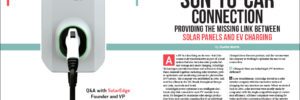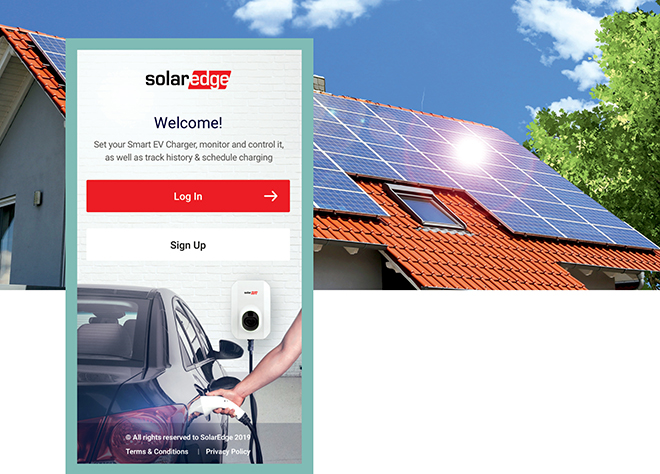
Q&A with SolarEdge Founder and VP of Marketing and Product Strategy Lior Handelsman
An EV is a fine thing on its own—but it becomes truly transformative as part of a local system that also includes solar panels, battery storage and smart charging. SolarEdge Technologies provides hardware and software to bring these elements together, including solar inverters, power optimizers and monitoring systems for photovoltaic (PV) arrays. The company was established in 2006, and now has offices in the US, Brazil, throughout Europe and Asia, Australia and Israel.
SolarEdge’s power optimizer is an intelligent electronic chip that connects to each PV module in an array. It’s designed to maximize solar energy production from each module, ensuring that if an individual module underperforms, it won’t affect the performance of other modules in the string.
SolarEdge’s EV Charging Solar Inverter is an Energy Star-certified Level 2 EV charger that is integrated into a PV inverter. It features a solar boost mode that uses power from solar panels and the grid simultaneously to boost charging speeds.
Now the company has introduced a Smart EV Charger. SolarEdge founder and VP of Marketing and Product Strategy Lior Handelsman chatted with Charged about the new product, and the various ways his company is working to optimize the sun-to-car connection.
Charged: How are SolarEdge’s PV inverters different?
Lior Handelsman: SolarEdge started as a solar inverter company with the innovative notion of changing the way inverters are made. When we started back in 2006, solar inverters were mostly made by companies with the single competitive angle of conversion efficiency. All these companies were aiming for better and better conversion efficiency of the inverter itself. Of the kilowatts [that come in] to the inverter input port, 96% or 97% should go out the other side.
When we looked at these, [we found] a lot of disadvantages in the way certain inverters are made. They were not connected, so we couldn’t use telemetry from them, and also a lot of the energy was lost on the roof already because of system inefficiencies: shading between the different modules, mismatches between solar panels on the roof, or nonlinear losses in the energy conversion on the roof.
To make a long story short, we invented a new inverter topology, [including] module power optimizers—a type of electronics that’s installed right next to every panel on the roof—and a simpler web-connected cloud-controlled inverter. All together it created this system which was much more powerful. It brought more value to the system owner by producing more power, and it brought more value to the installer by making the installation and the design easier, and by allowing them to provide the most services and the most monitoring and remote control.
So, this is our core—a lot of innovation, power electronics, the cloud connection, system innovation, electronics software. And it actually was quite a big success, because today we are the largest solar inverter company in the world. We have around $1.4 billion in sales of solar inverters.
Over the years, the company evolved to do smart energy. We added storage to our solar systems—that is now something that is very popular in many markets. And we added the ability to control loads and smart energy devices around the home [in order to optimize] the electric bill and consumption. We’ve added smart connectivity to our inverters to [aggregate] them into what we call virtual power plants, which is a cloud software solution that we sell to utilities. And we’ve now added the ability to charge EVs, all within the realm of the smart solar energy system.
Charged: Tell me how the Smart EV Charger works, and what the philosophy is behind it.
Lior Handelsman: First of all, it’s an AC charger for the home, but we’ve added a few abilities to it based on where we’re coming from. The first one is that it fits in the same software link to our solar production product, meaning that we can optimize your overall [electricity] consumption and production around the home. So, we learn all the times that you actually need more charging. For example, let’s say that you’re a stay-at-home dad. You take your kids to school in the morning, you go back home, you plug in the charger. But you actually don’t need to charge now—you can wait a little bit and charge later. What we will do is make sure that we charge the car when the solar power is available, so you can charge with free solar energy rather than buying expensive grid energy.
Then we can [bring] into that same ecosystem the battery, the EV charger, and even some other small devices around the home to optimize your electric bill. By shifting the time of charge and controlling the amount of charge, we can control the charge linearly. So, if you now have 3 kilowatts of available solar power, we can make sure that you only use these 3 available kilowatts to go into your car, in order to optimize your electrical bill. Of course, that’s if you can wait, if you don’t need the faster charge now.
Another thing we recommend that our customers do, if they already have a solar system, is to install the EV charger on the same circuit as the PV inverter. This brings two major advantages. One, we can make the charge faster than a regular charger. Most chargers are limited in their charging power by the size of the circuit breaker that they are connected to the grid with. For example, if you have a 32-amp breaker, that’s as fast as you can charge, even if your charger [can handle more power] than that.
By placing your charger on the same circuit as the PV inverter, we can take maximum power from the grid. On top of that, we power the cells directly from the sun, or from the battery, to give you a very fast charge, 40 amps or even faster. With your smart charger on the same circuit as the solar system, we make sure that we never go above the grid consumption that is allowed, but we can add more power from the PV or from the battery in order to make your charging faster.
The other thing is that in many homes, there is a scarcity of high-power breakers available in the electrical panel. That means that when you want to install an EV charger, you need to install a new panel, which is expensive. Here again, you can use the same breaker as the PV system, and save one high-power breaker. That is a pure and simple reduction of the installation cost of a smart charger.

Charged: Will the Smart EV Charger only work with your solar systems, or will it work with other ones as well?
Lior Handelsman: It won’t fit every system. Even if you don’t have a solar system at all, and you buy the smart charger, it will provide charging and it will leverage your existing grid connection as much as possible. If you want to enjoy the overall integration, all the features that I just mentioned—faster charging than the breaker size, the ability to save a breaker, and the overall energy optimization—yes, you need a SolarEdge inverter for that.
If you don’t have a SolarEdge inverter, you can do simpler optimizations such as time of use. If your utility offers time-of-use pricing you can program this charger to charge after 2 am [for example]. So, basic optimization, like any other [smart] charger in the market, you can do. For more sophisticated optimization, you need the SolarEdge inverter.
Charged: You’ve launched your Smart EV Charger in North America. When will it be available elsewhere?
Lior Handelsman: Prior to launching this product, we launched a solar inverter that has an integrated smart charger. That product is already available globally. The standalone smart charger is now being launched in North America. It will be launched in the rest of the world around Q3.
Charged: What kind of cost savings could be available when using the solar energy directly to charge your car?
Lior Handelsman: It really depends on the specific financials of electricity where you live. In a time-of-use area, you can reduce the cost of charging your car by up to roughly 30% by basically using free solar energy to charge your car rather than buying energy from the grid. We’ve seen some cases where you can cut the cost of charging your car by half. Take Hawaii as an example: you can probably get to an improvement of your rate of self-consumption by 40%.
Charged: Do your systems also integrate with programs the utilities offer to control your appliances?
Lior Handelsman: Yes. Demand response and virtual power plant. That is built into every SolarEdge product.
Charged: Do these EV charging systems need to be installed by a SolarEdge-certified installer, or can they be installed by anyone?
Lior Handelsman: The chargers can be installed by any qualified electrician. In order to connect this to the smart inverter and do the integration into the system, you need to have a SolarEdge installer account, but you can get trained online how to do that.
This article appeared in Charged Issue 49 – May/June 2020 – Subscribe now.
source https://chargedevs.com/features/the-sun-to-car-connection-solaredge-provides-the-missing-link-from-solar-panels-to-ev-charging/
No comments:
Post a Comment